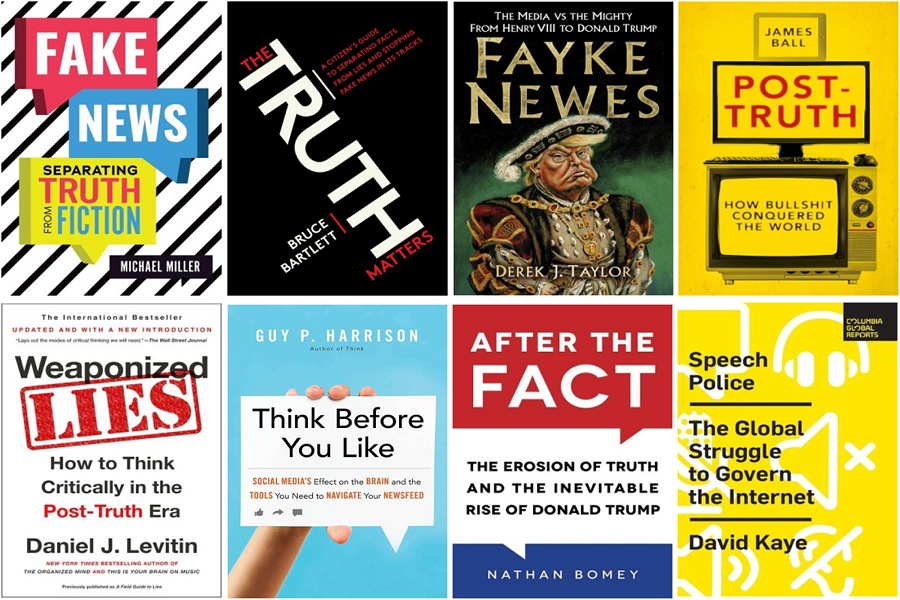Article provided by National Library Board
The fake news law explained
Sign up now: Get ST's newsletters delivered to your inbox

A selection recommended by the National Library Board.
PHOTO: NATIONAL LIBRARY BOARD
Follow topic:
You chance upon an article on a sociopolitical site saying human rights are being curtailed in Singapore because demonstrations and protests are as good as banned. Fake news, or an opinion?
According to The Straits Times' senior political correspondent Tham Yuen-C, it is a statement of opinion. Together with Singapore Management University Associate Professor of Law Eugene Tan, she explains what the Protection from Online Falsehoods and Manipulation Act (Pofma) entails.
Exercise judgement when reading news
Under Pofma, a "false statement of fact" is defined as a false or misleading statement which a reasonable person would consider to be a representation of fact. This means that the above statement is an opinion because it is within a person's rights to feel that the law is curbing his ability to protest.
Good media literacy is, therefore, the best defence against fake news.
Read the whole article, check the date and look out for tell-tale signs, such as photoshopped photos. As far as possible, go to the original source or cross-check with public records or fact-checking websites.
Emphasis on responsible speech
Pofma deals with individuals or organisations that seek to spread falsehoods that undermine public interest. There are concerns that one may run afoul of the law easily but nothing will happen unless the fake news being shared is a false statement of fact that could cause damage to society.
Pofma is most concerned with responsible speech. This is because fake and irresponsible news can severely damage a country's peace and stability.
Check out some of our library e-books and audiobooks on how to tackle fake news:
1. FAKE NEWS: SEPARATING TRUTH FROM FICTION (2018) by Michael Miller
E-book available here.
This title explores journalistic and fact-checking standards, constitutional protections and real-world case studies, which help readers identify the mechanics, perpetrators, motives and psychology of fake news.
2. THE TRUTH MATTERS: A CITIZEN'S GUIDE TO SEPARATING FACTS FROM LIES AND STOPPING FAKE NEWS IN ITS TRACKS (2017) by Bruce Bartlett
E-book available here.
Audiobook available here.
The Truth Matters presents actionable tips on reading critically, judging sources, using fact-checking sites, avoiding confirmation bias, identifying trustworthy experts and more.
3. FAYKE NEWES: THE MEDIA VS THE MIGHTY, FROM HENRY VIII TO DONALD TRUMP (2018) by Derek J Taylor
E-book available here.
Historian and international journalist Derek Taylor tracks the long and bloody fight between the press and those in power.
4. POST-TRUTH: HOW BULLSHIT CONQUERED THE WORLD (2017) by James Ball
E-book available here.
An analysis of what is being spread, who is spreading it, why it works and, most importantly, what we can do to tackle fake news.
5. WEAPONIZED LIES: HOW TO THINK CRITICALLY IN THE POST-TRUTH ERA (2017) by Daniel J Levitin
E-book available here.
The New York Times bestselling author Daniel Levitin shows how to disarm fringe theories, fake news, and pseudo-facts, and get the American mind back on track.
6. THINK BEFORE YOU LIKE: SOCIAL MEDIA'S EFFECT ON THE BRAIN AND THE TOOLS YOU NEED TO NAVIGATE YOUR NEWSFEED (2017) by Guy P Harrison
E-book available here.
Guy P. Harrison, an upbeat advocate of scientific literacy and positive scepticism, demonstrates how critical thinking can enhance the benefits of social media while giving users the skills to guard against its dangers.
7. AFTER THE FACT: THE EROSION OF TRUTH AND THE INEVITABLE RISE OF DONALD TRUMP (2018) by Nathan Bomey
E-book available here.
This book explores how the convergence of technology, politics and media has ushered in the misinformation age, sidelining the truth and threatening our core principle of community.
8. SPEECH POLICE: THE GLOBAL STRUGGLE TO GOVERN THE INTERNET (2019) by David Kaye
E-book available here.
David Kaye, who serves as the United Nations' special rapporteur on free expression, takes us behind the scenes and introduces us to journalists, activists and content moderators whose stories bring clarity and urgency to the topic of censorship.


